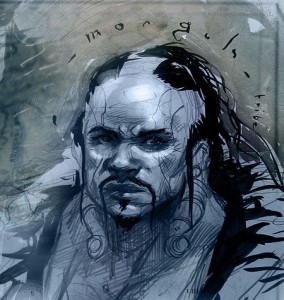I made mention of the Mongoliad writing project when it was first announced in late spring (my May 31, 2010 posting). The project features Neal Stepheonson and Greg Bear, both well known science fiction writers (in fact, both have written novels that incorporate nanotechnology), amongst a cast of other writers, artists, techno types, and others. They’re forging into 21st century publishing with a model that is lifted in part from the 19th century, stories produced serially and available by subscription, but made available with contemporary technology, the interrnet. I guess you could call it ‘steam punk publishing’.
Last week, a free preview was made available and registration was opened. Here’s the view from Andrew Leonard at Salon.com,
Behold the power of branding! Chapter I of “The Mongoliad” launched online this week, and I plunked down $9.99 for a year’s subscription, sight unseen, simply because Neal Stephenson’s name was attached. …
But after spending some time with the site and reading the first chapter, it is not exactly clear to me exactly how much Stephenson is baked into this project. He is the co-founder and chairman of Subutai, the start-up that is producing “The Mongoliad.” But the content-creation is a group effort. This serial digital novel is being produced online by a team of writers , artists, hackers and sword-fighting geeks — another big name involved is Greg Bear, also a veteran science fiction author. …
“The Mongoliad” is supposed to be more than “just” a book. Eventually the intention is to incorporate multimedia offerings, along with the hypertext-branching contributions of a user community extending far beyond the core team.
Leonard goes on to express his hope that Mongoliad will be a grand adventure. He really is a Stephenson fan and seems to be genuinely looking forward to reading this experiment in publishing/social media enhancing/serializing a novel. Kit Eaton at Fast Company (Neal Stephenson’s Novel-Redefining Novel, “The Mongoliad,” Launches, Online) is another fan,
Ghengis Khan shook up the world in the 12th Century, and now in the 21st Century Neal Stephenson’s novel about him may shake up the publishing world: It’s partly interactive, partly social media, and wholly digital.
The Mongoliad promises to be unlike any other book ever written. For starters it’s written, in part, by Neal Stephenson, whose ideas in earlier novels like Snow Crash and The Diamond Age have contributed to many modern marvels like Google Earth and augmented reality. When you learn sci-fi writer Greg Bear is contributing to the team effort too, it makes the whole thing even more promising.
The innovation in The Mongoliad isn’t in its team writing effort, however: It’s in the entire concept of a serialized, dynamic, digital “book” that includes video, imagery, music, and background articles among the text of the storyline and comes with a social media companion, with which fans/readers can comment and interact.
In fact it looks as if they are incorporating fan fiction into their overall plan. If you go to the Mongoliad website, you are encouraged to add your stories and artwork to the site. This is from their ‘terms of service’,
Contributor Submissions
1. Policy. We welcome the submission of text, stories, vignettes, paragraphs, concepts, characters, ideas, poems, songs, images, animations, or interactive features submitted by registered contributors for potential publication on the Site (“Contributor Submissions”). Subutai grants you a limited, non-exclusive, non-transferable and revocable license to modify, broadcast, and transmit Content solely in order to create and submit Contributor Submissions to Subutai.
You understand that whether or not such Contributor Submissions are published, Subutai cannot guarantee proper attribution with respect to any submissions because of the interactive nature of the Site.
It’ll be interesting to see whether or not this works purely from the perspective of its business model. As for the story itself, I’m not loving it so far. First, a précis. It’s the thirteenth century in Europe and the Mongolians have a conquered a chunk of it. (Apparently, they did conquer a good chunk by 1241 and were about to conquer the rest when Ögedei Khan, then current Mongol ruler, died and their general, Subitai, according to custom had to return to Mongolis. See: Wikipedia essay)
In Mongoliad, there is no withdrawal of the Mongol forces and they are poised to sweep Europe meanwhile a small band of European knights gather to fight (from the Mongoliad Welcome page),
It’s spring of 1241, and the West is shitting its pants (that’s “bewraying its kecks” for you medieval time-travelers).
The Mongol takeover of Europe is almost complete. The hordes commanded by the sons of Genghis Khan have swept out of their immense grassy plains and ravaged Russia, Poland, and Hungary… and now seem poised to sweep west to Paris and south to Rome. King and pope and peasant alike face a bleak future—until a small band of warriors, inheritors of a millennium-old secret tradition, set out to probe the enemy.
Their leader, the greatest knight of their order, will set his small group of specially trained warriors on a perilous eastern journey. They will be guided by an agile, elusive, and sharp-witted adolescent girl, who believes the master’s plan is insane. But this small band is the West’s last, best hope to turn aside the floodtide of the violent genius of the Steppes kingdoms.
In the preview chapter (which is free), we meet Haakon who’s obviously one of the small band of warriors fighting for Europe. At this point, he’s engaging in some sort of sword fighting duel in a Mongol arena while the crowds roar for blood. We never learn much more about him or any of the other characters we’re introduced to as the preview is designed to draw us into buying a subscription so we can find out more. I’m not a big fan of the writing that I see in the preview,
Haakon wanted to roar with anger, but it came out as a strangled laugh. “I am about to do battle with a demon,” he complained, “and you want me to–”
“It’s no demon,” Brother Rutger said, and spat on the loose ocher ground that had been tracked down the tunnel on the boots of surviving combatants. “It’s a man dressed as one.” He rammed the helm down onto Haakon’s head and slapped him on the ass. Even through surcoat, chain mail, gambeson, and drawers, the impact came through solidly. “Oh yes,” he added, “and the Red Veil. We would also like to know what is on the other side.”
Haakon grunted as he adjusted the helmet to suit him. The mysterious Veil. He might have seen it several weeks ago when a group led by the physician Raphael had been sent to retrieve Illarion, the ailing Ruthenian.
Now, their party had divided again, and Feronantus and his team were off on their secret mission–while Haakon and the rest of the Shield-Brethren remained to compete against the champions of the Mongol Empire.
Rutger put his hand on Haakon’s shoulder. They regarded each other silently. Saying goodbye would be worse than useless, since Rutger and the others would see it as a premature admission of defeat, and it might demoralize them. Haakon knew he would be back among them in less time than it took to run out to the gutter and take a shit.
I also have some questions about the politics of it all. Here are a couple pictures from the site, Haakon first,

Art by Jamie Jones (from Mongoliad site)
And here’s one of the two Mongolian thug images currently available,

Concept art from Aleksi Briclot (from Mongoliad site)
This is just the beginning of the series and I’m hoping they head away from seems to be a pretty standard storyline where pretty, blond, white people struggle and eventually turn the tide against a demonic, dark-haired and darker-skinned people.

